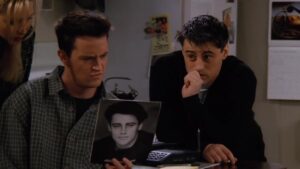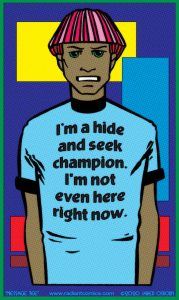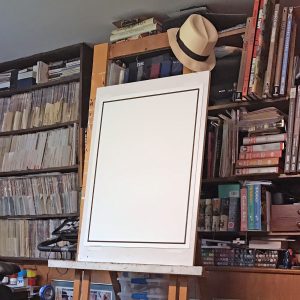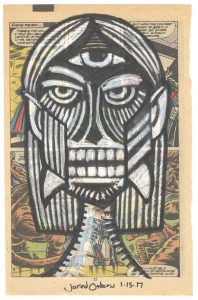I feel like writing another “Friends” walkthrough so here we go. Looks like I’m on episode 12 of Season Three. It’s called “The One With All the Jealousy.” The episode originally aired on January 16, 1997. I watched it as it aired so let me check my calendar and see what else I did that day. I’ve got two notations. I took money out of the ATM near my home but then spent $55 at Games Express all the way down in NYC. I must have bought a video game but I don’t know which one. I also don’t know why I’d go all the way into NYC to buy a game since I wasn’t working at Marvel that day. A bit of a mystery to me.
The show starts with Chandler getting in trouble for cracking wise to Rachel on her first day of a new job. This is the beginning of Rache’s career in fashion. The first two seasons of her being a waitress are done. Ross making snorting noises as he shows off his dinosaur tie is good stuff. Phoebe walks in with a ton of purses for Rachel to choose from. The jealousy is starting early as Ross finds out that Mark, the one who got Rachel the job, is taking her out to lunch for her first day. Chandler has to go to a bachelor party which we never see. It’s just needed plot-wise. Here comes the theme song.
New scene in Chandler’s apartment with Ross trying to deal with his jealousy. Joey has an audition for a play. That must be the second plot for the episode. Joey’s small vocabulary leads to some funny business.
A quick scene change and Now Rachel is at work with Mark and Ross calls. More jealousy is coming up. I have to say that Ross’s jealousy can be awkward and ugly but he wasn’t wrong. Mark was sure acting like he was interested in Rachel and I think the plot bore that out in later episodes. This plot makes me feel sorry for Ross. He sees his own doom ahead and has no idea how to handle it. Rachel acts like it’s all in his head but it it’s really in Mark and Rachel’s behavior. The office scene is really awkward.
Now we’re at Monica’ job where she’s working at a 1950’s costume diner. She’s in a pink fuzzy sweater, blonde wig, with a stuffed bra. Now I remember this plot (third plot of the episode). She’s got a crush on her coworker Julio who is a poet with a Spanish accent. He finds her beautiful but empty. He hooks up with her of course and it’s not until later on that we find out that he thinks she’s shallow.
Now we go to Joey’s audition where he is singing for a musical. He belts out a funny song but then we discover he lied on his resume and they think he has three years dance experience with Twyla Tharp and five years with the American Balet Theatre. Of course he doesn’t which is going to lead to great embarrassment later on in the episode. Between Ross’s jealousy and Joey’s lying there is a lot of uncomfortable awkwardness in this episode. Joey dancing at home is also good stuff.
Chandler is trying to hire a stripper for the bachelor party. Miss Crystal Chandelier. Meanwhile Julio wrote Monica a poem during their date and reads it to the gang. It’s about an empty vase that Phoebe susses out is Monica. Should she break it to Monica? First she has to explain it to Chandler. In a funny bit Joey reads the poem slowly but he gets the poem’s meaning even as Chandler didn’t.
Back to Ross’s awkward jealousy. He’s marking his territory. He sends so many flowers to Rachel that they take up her office. She doesn’t appreciate it as you might imagine. Now here comes a barbershop quartet to sing to her. Or should I say embarrass her. We switch locations and they’re at the apartment with Rachel dressing down Ross for his behavior. I feel sorry for Ross. He can’t stop his doom. He can only make it worse.
The three boys are in the coffee shop and they’re telling Ross how it is. They don’t trust Mark either and are on Ross’s side. But there is still nothing he can do about it. Chandler gives him bad advice. Joey is funny predicting the future.
Mark is back at the office with Rachel and his (Mark’s) girlfriend. Now we go to sitcom land where Ross overhears Mark, thinks Mark is with Rachel, and Ross makes a fool of himself. Ross continues to doom himself. But Rachel sure doesn’t help.
It’s the culmination of the Joey plotline. A twist happens where Joey has to teach the rest of the people auditioning for the show how to dance. Of course he can’t.
Before we get to the end of that plot it’s Monica buying a vase for Julio and Phoebe has to break the news to her. Monica is the empty vase. Monica confronts Julio. This is a little awkward too but it’s still funny. Julio tells Monica she’s not the empty vase. All American women are. That doesn’t go over well.
Back to Joey. He’s taught the class his own terrible dance. He’s put on the spot once more and he runs out of the studio. A funny run.
Chandler is back from the unseen bachelor party and at the coffee shop with Rachel. That bachelor party plot wasn’t much. It was all just something for Chandler to talk about this episode. Our standard three plots were: Joey’s dancing, Monica’s empty vase, and Ross’s jealousy. The bachelor party was a rare fourth plot element that wasn’t really fleshed out. It wasn’t really a plot but was needed for a finishing joke in Ross and Rachel’s plot.
Ross come into the coffee shop to apologize to Rachel. Ross is sweet and Rachel is forgiving. Then we find out that Ross and his son Ben have a playdate with the stripper from the bachelor party (this end joke was the whole reason for all the bachelor party talk). The tables are turned and Rachel gets jealous. This is kind of the end of Rachel’s jealousy but not Ross’s. Chandler gets a zinger in. Monica ends the show by hiring the barbershop quartet to sing an insulting song to Julio. And we’re out.
Let me check the internet to see what was cut out of the syndicated (and Netflix and HBO) version of this episode. Looks like they cut out Joey’s being able to grok the poem. That was a funny bit. Plus another scene with Joey talking about his dance class. And a little bit of Chandler at the end. I’m glad I watch these old DVD copies with all the extra material in them. They’re not HD but they’re funnier.
I checked my ratings from when I rated all the episodes on iTunes and as I guessed I gave this episode three out of five stars. It was solid but not one of the better ones. A little too much awkwardness for my taste but still some laughs.




